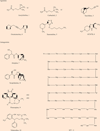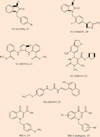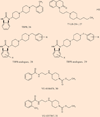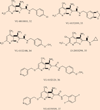The antipsychotic potential of muscarinic allosteric modulation
- PMID: 20520852
- PMCID: PMC4780339
- DOI: 10.1358/dnp.2010.23.4.1416977
The antipsychotic potential of muscarinic allosteric modulation
Abstract
The cholinergic hypothesis of schizophrenia emerged over 50 years ago based on clinical observations with both anticholinergics and pan-muscarinic agonists. Not until the 1990s did the cholinergic hypothesis of schizophrenia receive renewed enthusiasm based on clinical data with xanomeline, a muscarinic acetylcholine receptor M(1)/M(4)-preferring orthosteric agonist. In a clinical trial with Alzheimer's patients, xanomeline not only improved cognitive performance, but also reduced psychotic behaviors. This encouraging data spurred a second clinical trial in schizophrenic patients, wherein xanomeline significantly improved the positive, negative and cognitive symptom clusters. However, the question remained: Was the antipsychotic efficacy due to activation of M(1), M(4) or both M(1)/M(4)? Classical orthosteric ligands lacked the muscarinic receptor subtype selectivity required to address this key question. More recently, functional assays have allowed for the discovery of ligands that bind at allosteric sites, binding sites distinct from the orthosteric (acetylcholine) site, which are structurally less conserved and thereby afford high levels of receptor subtype selectivity. Recently, allosteric ligands, with unprecedented selectivity for either M(1) or M(4), have been discovered and have demonstrated comparable efficacy to xanomeline in preclinical antipsychotic and cognition models. These data suggest that selective allosteric activation of either M(1) or M(4) has antipsychotic potential through distinct, yet complimentary mechanisms.
Copyright 2010 Prous Science, S.A.U. or its licensors. All rights reserved.
Conflict of interest statement
DISCLOSURES
T.M. Bridges, E.P. LeBois, C.R. Hopkins, M.R. Wood and C.W. Lindsley state that they have no potential conflicts of interest to disclose.
Figures








References
-
- Andreasen NC. Schizophrenia: the fundamental questions. Brain Res Rev. 2000;31(2–3):106–112. - PubMed
-
- Karayiorgou M. Genetic aspects of schizophrenia. Clin Neurosci Res. 2001;1(1–2):158–163.
-
- Meador-Woodruff JH, Healy DJ. Glutamate receptor expression in schizophrenic brain. Brain Res Rev. 2000;31(2–3):288–294. - PubMed
-
- Jablensky A. Subtyping schizophrenia: Implications for genetic research. Mol Psychiatry. 2006;11(9):815–836. - PubMed
-
- Lindsley CW, Shipe WD, Wolkenberg SE, Theberge CR, Williams DL, Sur C, Kinney GG. Progress towards validating the NMDA receptor hypofunction hypothesis of schizophrenia. Curr Top Med Chem. 2006;6(8):771–785. - PubMed
Publication types
MeSH terms
Substances
Grants and funding
LinkOut - more resources
Full Text Sources
Other Literature Sources
